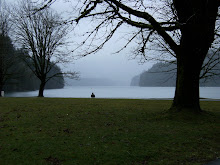This is oversimplifying a bit, but there are four factors that come into play in every conflict.
Number Four is luck. You can't do anything about luck- you can become more aware and adaptable, you can change in response to luck, but you can't make luck go away. Like many things in life, you can do stuff about you that can change the effect luck can have, but don't pretend that you are changing luck itself.
Factor one, of course, is yourself. A lot of training focuses on this factor- how to move. What you can do.
But the second factor in the fight, the threat or threats, are part of the equation too. They change everything- hitting correctly is different than hitting a specific object correctly- especially when the object moves and doesn't want to be hit. The sheer physical presence of threats change the equation, but more so- the threat moves, makes decision, has his or her or their own goals and plans and tactics and actions. At a very simple but profound level your training changes when it shifts from "How do I strike, kick or throw?" to "How do people break or fall?"
The third factor is the environment. It is always in play, but in most training it is minimized so that you can work on one or the other two without distractions. It affects everything in large and small ways and covers everything from footing to found weapons to temperature and clothing and internal chemicals states.
Note well: a good fighter is someone who knows all four factors. A great fighter understands the dynamics and the interactions between each and all of the factors.
Thursday I took my team heavily into environmental fighting. There was a short class and practice on using walls and corners and curbs and found weapons and doors and... Then they got a little practice. Then we went to the room.
The room was about forty feet by sixty in an abandoned warehouse. Part was set up for classes so there was a big desk, chairs, benches. It was cluttered with the trash that accumulates in abandoned buildings. Concrete pillars and water pipes ran from floor to ceiling. Except for six green glo-sticks it was pitch dark.
For an hour, we brawled in there. Thirteen experienced fighters in full tactical gear (minus live weapons) going at it specifically looking for opportunities to smash heads into walls or bend backs over corners. It was a blast- hot and sweaty, fun and instructional. Chairs flew, both at heads and kicked into the knees of a charging threat. We found ourselves frisking the opponent in the middle of the grapple and pulling things from his belt to use as a weapon (handgun magazines make great fist loads). One team member noticed that if he threw a glo-stick, eyes would follow the moving light and he could blind-side people.
Grappling I found myself torn away with the facemask/spine twist throw I'd taught 'em yesterday and had to deal with two at a time at grappling range, one of whom had over a hundred pounds on me.
It was an incredible day. To sum it up in a scene: Shoulder slammed my guy off balance and slip into control of his neck and near-side arm and pivot, dropping... and stop. His eye with both our body weights behind it is poised over the corner of the bench. "You see that?" I ask. "Yeah, that would suck," he says. I loosen the grip and give him time to push away from the danger and continue the drop where we both continue fighting on the ground.
Full scale judo falls on concrete in gear. Strangles against the edge of the body armor. Telephone book slams. Flying, swinging and sliding furniture.
And at the end: "Injuries?" Fat lips. Scrapes. Bruises (almost everyone has a holster-sized bruise on their hips from slamming into the floor or wall). Nothing else.
I can't think of any other group I could do this with- the skill and absolute control make them, in my opinion, the best I've seen in this business.
Good times, baby, good times.
Subscribe to:
Post Comments (Atom)



No comments:
Post a Comment